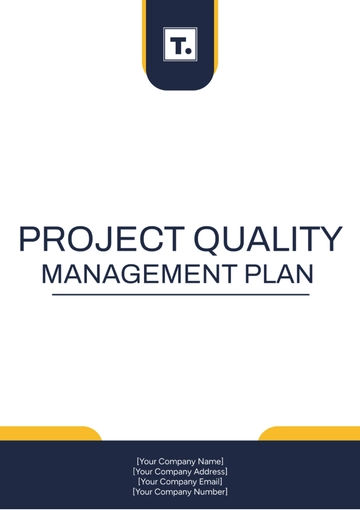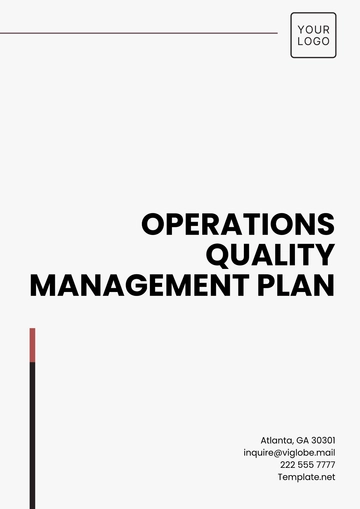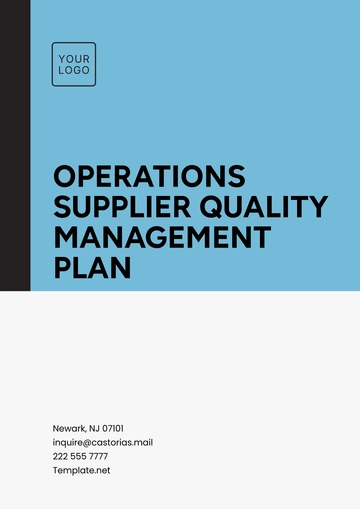Free Construction Quality Management Plan

I. Introduction
The Construction Quality Management Plan (CQMP) is a strategic framework developed by [Your Company Name] to ensure that all construction activities adhere to the highest quality standards and legal regulations in the United States. This plan is designed to cover every phase of a project, from initial design and procurement through construction, testing, and final delivery. By establishing clear quality control and assurance measures, the CQMP ensures that all project objectives, including safety, functionality, and sustainability, are met.
[Your Company Name] integrates industry best practices and complies with key standards, such as those outlined by the Occupational Safety and Health Administration (OSHA), the American National Standards Institute (ANSI), and local building codes. This comprehensive approach minimizes errors, reduces costly rework, and promotes consistency across teams. By adhering to this plan, all stakeholders—from project managers to contractors and subcontractors—are provided with clear guidelines to execute tasks correctly and efficiently, resulting in high-quality project outcomes that meet or exceed client expectations.
II. Quality Objectives
The primary objectives of this Construction Quality Management Plan are:
To define quality standards and specifications required for the project.
To establish a clear process for quality assurance and control activities.
To identify roles and responsibilities for quality management.
To implement effective communication and documentation practices.
To provide continuous improvement strategies.
III. Roles and Responsibilities
Effective construction quality management requires clear delegation of tasks and responsibilities across the project team. Each role outlined below plays a crucial part in ensuring that quality standards are met at every stage of the project. By clearly defining these roles, [Your Company Name] ensures accountability and smooth coordination, which is essential to maintaining compliance with industry regulations and client expectations.
Outlined below are the key roles involved in quality management and their respective responsibilities:
Role | Responsibilities |
|---|---|
Project Manager | Oversee the overall quality of the project, ensure adherence to quality standards, coordinate with other roles, and report to stakeholders. |
Quality Control Manager | Implement quality control activities, conduct inspections, and manage quality documentation. |
Site Supervisor | Monitor daily work practices to ensure compliance with quality, health, and safety standards. |
QA/QC Inspector | Perform inspections and tests on materials and workmanship to ensure compliance with project specifications. |
IV. Quality Standards
Adherence to established quality standards is critical for delivering a construction project that meets both regulatory requirements and client expectations. [Your Company Name] commits to following globally recognized and project-specific standards to ensure a consistent and high-quality outcome. This section outlines the primary standards that will guide the construction process, ensuring that all materials, workmanship, and processes comply with the relevant regulations and benchmarks, ultimately leading to a successful project completion.
This project will adhere to the following quality standards:
ISO 9001:2050 Quality Management Systems
American Society for Testing and Materials (ASTM) standards
Project-specific specifications and requirements
V. Quality Assurance Process
The Quality Assurance (QA) process is a proactive approach designed to prevent defects and ensure that the construction project meets or exceeds specified quality standards. [Your Company Name] implements a robust QA process that focuses on planning, training, and continuous improvement to guarantee successful project execution. Below are the key components of this process:
1. Preparation and Approval of a Quality Management Plan
The Quality Management Plan (QMP) is the foundational document that outlines the quality objectives, standards, and procedures for the project. This plan is developed in the early stages of the project and includes input from key stakeholders such as project managers, architects, engineers, and contractors. Once prepared, the QMP is reviewed and approved by senior management and other relevant authorities to ensure that it aligns with regulatory requirements and client expectations.
2. Conducting Preliminary Reviews and Risk Assessments
Before construction begins, [Your Company Name] performs detailed preliminary reviews and risk assessments to identify potential quality risks that may arise during the project. This phase involves reviewing design plans, material specifications, and project timelines to ensure all quality requirements are incorporated. Risk assessments also help in identifying areas that need additional attention, such as complex engineering tasks or potential issues with suppliers.
3. Establishing Quality Benchmarks and Performance Metrics
To ensure consistent performance throughout the project lifecycle, quality benchmarks and performance metrics are established. These benchmarks serve as standards that all team members must adhere to, while performance metrics allow for continuous monitoring and evaluation of progress. Key performance indicators (KPIs) such as defect rates, inspection pass rates, and adherence to schedules are used to assess overall quality performance.
4. Training Personnel on Quality Procedures and Expectations
A well-trained team is essential for maintaining high-quality standards. [Your Company Name] ensures that all personnel, including contractors and subcontractors, receive comprehensive training on the quality procedures outlined in the QMP. Training sessions cover everything from safety standards and workmanship requirements to documentation practices and inspection protocols. Regular refresher courses are also conducted to keep everyone aligned with evolving project demands and industry regulations.
VI. Quality Control Activities
The Quality Control (QC) activities are essential to ensure that the construction project complies with the specified quality standards and regulatory requirements. [Your Company Name] follows a rigorous QC process that includes continuous monitoring, testing, and corrective measures to address any potential issues during construction. By implementing these activities, the company ensures that both the materials used and the workmanship meet the highest standards of quality.
1. Regular Site Inspections and Audits
[Your Company Name] conducts regular site inspections to monitor ongoing work and ensure that all activities comply with the approved Quality Management Plan. These inspections are scheduled at key project milestones and unannounced audits are conducted to verify adherence to quality, safety, and regulatory standards. Any deviations or non-compliant practices identified during these inspections are immediately addressed.
2. Testing of Materials and Assembled Components
Quality control extends to thorough testing of materials before they are used in the project. This includes verifying that all materials meet project-specific requirements and comply with standards such as ASTM. In addition, assembled components undergo performance testing to confirm their functionality and safety before final installation. Tests range from load-bearing assessments to durability checks, depending on the component in question.
3. Non-Conformance Reporting and Corrective Action Management
When any issues are identified during inspections or testing, non-conformance reports (NCRs) are filed. NCRs document the nature of the problem, including the root cause and possible impacts on the project. A corrective action plan is then developed to address the issue and prevent it from reoccurring. [Your Company Name] ensures that corrective actions are implemented immediately to avoid delays and maintain quality.
4. Documentation and Record-Keeping of All Quality Control Activities
Accurate and organized documentation is critical for tracking quality control efforts and ensuring compliance with industry standards and client requirements. [Your Company Name] maintains thorough records of all quality control activities to provide transparency, traceability, and accountability throughout the project. Below is a list of the essential documents and records maintained:
Inspection Reports
Detailed reports from regular site inspections and audits, including findings, issues identified, and recommended corrective actions.
Test Results
Documentation of all material and component tests, including results, testing methods, and compliance with project-specific standards such as ASTM.
Non-Conformance Reports (NCRs)
Records of non-conformance issues identified during inspections or testing, detailing the nature of the problem, root cause, and resolution plan.
Corrective Action Records
Documentation of the corrective actions implemented to resolve non-conformance issues, including verification that the corrective actions were effective.
Daily Logs
Daily quality logs maintained by the site supervisor or quality control manager, tracking ongoing activities, inspections, and any quality-related incidents.
Material Submittals and Approvals
Records of all materials submitted for approval before use, including test certificates, manufacturer data, and verification of compliance with project specifications.
Audit and Compliance Reports
Documentation of internal and external audits conducted to verify compliance with industry regulations and contractual obligations.
Final Quality Reports
A comprehensive summary of all quality control activities and results, compiled at the end of the project to ensure that all quality objectives were met.
VII. Communication and Documentation
Clear communication and meticulous documentation are vital to ensuring the consistent quality of a construction project. [Your Company Name] emphasizes the importance of continuous collaboration among all project stakeholders to promptly address quality concerns and keep the project on track. This includes:
Regular progress meetings and quality reviews.
Detailed reporting mechanisms for quality issues.
Maintaining updated project logs and quality records.
IX. Continuous Improvement
Continuous improvement is a core aspect of the quality management process at [Your Company Name]. The goal is to not only meet current quality standards but to consistently enhance processes, reduce errors, and increase efficiency. By applying continuous improvement strategies, the project team can identify recurring issues, implement more effective solutions, and prevent future problems. These efforts contribute to a culture of excellence, driving the project toward better outcomes and long-term success. Continuous improvement also ensures that [Your Company Name] remains competitive by adapting to new technologies, best practices, and evolving industry standards.
To achieve this, the team will focus on several key activities. First, the root causes of any quality issues will be thoroughly analyzed to determine underlying problems. This involves using techniques like root cause analysis or the "5 Whys" method to trace issues to their origin. Corrective actions will be implemented to resolve immediate concerns, while preventive measures are designed to ensure that similar issues do not arise in the future. Additionally, the quality management processes will be regularly reviewed and updated based on lessons learned and industry advancements. This continuous feedback loop allows [Your Company Name] to refine its approach, adapt to changing project needs, and improve the overall quality of deliverables over time.
Identifying and analyzing root causes of quality issues.
Implementing corrective actions and preventive measures.
Reviewing and updating quality management processes periodically.
The Construction Quality Management Plan (CQMP) outlined by [Your Company Name] is a comprehensive framework designed to ensure that every aspect of the construction process adheres to the highest quality standards. By clearly defining roles, implementing stringent quality control and assurance processes, and fostering a culture of continuous improvement, this plan provides the necessary structure to deliver projects that meet or exceed client expectations. Through proactive communication, thorough documentation, and a commitment to excellence, [Your Company Name] will maintain quality throughout the project lifecycle, ensuring safe, efficient, and successful project completion.
- 100% Customizable, free editor
- Access 1 Million+ Templates, photo’s & graphics
- Download or share as a template
- Click and replace photos, graphics, text, backgrounds
- Resize, crop, AI write & more
- Access advanced editor
Ensure top-quality standards with the Construction Quality Management Plan Template. This fully editable and customizable template allows you to establish clear quality guidelines for your project. Editable in our AI Editor Tool, it simplifies adjustments to meet specific project needs. Download today and streamline your quality management with Template.net.
You may also like
- Finance Plan
- Construction Plan
- Sales Plan
- Development Plan
- Career Plan
- Budget Plan
- HR Plan
- Education Plan
- Transition Plan
- Work Plan
- Training Plan
- Communication Plan
- Operation Plan
- Health And Safety Plan
- Strategy Plan
- Professional Development Plan
- Advertising Plan
- Risk Management Plan
- Restaurant Plan
- School Plan
- Nursing Home Patient Care Plan
- Nursing Care Plan
- Plan Event
- Startup Plan
- Social Media Plan
- Staffing Plan
- Annual Plan
- Content Plan
- Payment Plan
- Implementation Plan
- Hotel Plan
- Workout Plan
- Accounting Plan
- Campaign Plan
- Essay Plan
- 30 60 90 Day Plan
- Research Plan
- Recruitment Plan
- 90 Day Plan
- Quarterly Plan
- Emergency Plan
- 5 Year Plan
- Gym Plan
- Personal Plan
- IT and Software Plan
- Treatment Plan
- Real Estate Plan
- Law Firm Plan
- Healthcare Plan
- Improvement Plan
- Media Plan
- 5 Year Business Plan
- Learning Plan
- Marketing Campaign Plan
- Travel Agency Plan
- Cleaning Services Plan
- Interior Design Plan
- Performance Plan
- PR Plan
- Birth Plan
- Life Plan
- SEO Plan
- Disaster Recovery Plan
- Continuity Plan
- Launch Plan
- Legal Plan
- Behavior Plan
- Performance Improvement Plan
- Salon Plan
- Security Plan
- Security Management Plan
- Employee Development Plan
- Quality Plan
- Service Improvement Plan
- Growth Plan
- Incident Response Plan
- Basketball Plan
- Emergency Action Plan
- Product Launch Plan
- Spa Plan
- Employee Training Plan
- Data Analysis Plan
- Employee Action Plan
- Territory Plan
- Audit Plan
- Classroom Plan
- Activity Plan
- Parenting Plan
- Care Plan
- Project Execution Plan
- Exercise Plan
- Internship Plan
- Software Development Plan
- Continuous Improvement Plan
- Leave Plan
- 90 Day Sales Plan
- Advertising Agency Plan
- Employee Transition Plan
- Smart Action Plan
- Workplace Safety Plan
- Behavior Change Plan
- Contingency Plan
- Continuity of Operations Plan
- Health Plan
- Quality Control Plan
- Self Plan
- Sports Development Plan
- Change Management Plan
- Ecommerce Plan
- Personal Financial Plan
- Process Improvement Plan
- 30-60-90 Day Sales Plan
- Crisis Management Plan
- Engagement Plan
- Execution Plan
- Pandemic Plan
- Quality Assurance Plan
- Service Continuity Plan
- Agile Project Plan
- Fundraising Plan
- Job Transition Plan
- Asset Maintenance Plan
- Maintenance Plan
- Software Test Plan
- Staff Training and Development Plan
- 3 Year Plan
- Brand Activation Plan
- Release Plan
- Resource Plan
- Risk Mitigation Plan
- Teacher Plan
- 30 60 90 Day Plan for New Manager
- Food Safety Plan
- Food Truck Plan
- Hiring Plan
- Quality Management Plan
- Wellness Plan
- Behavior Intervention Plan
- Bonus Plan
- Investment Plan
- Maternity Leave Plan
- Pandemic Response Plan
- Succession Planning
- Coaching Plan
- Configuration Management Plan
- Remote Work Plan
- Self Care Plan
- Teaching Plan
- 100-Day Plan
- HACCP Plan
- Student Plan
- Sustainability Plan
- 30 60 90 Day Plan for Interview
- Access Plan
- Site Specific Safety Plan



